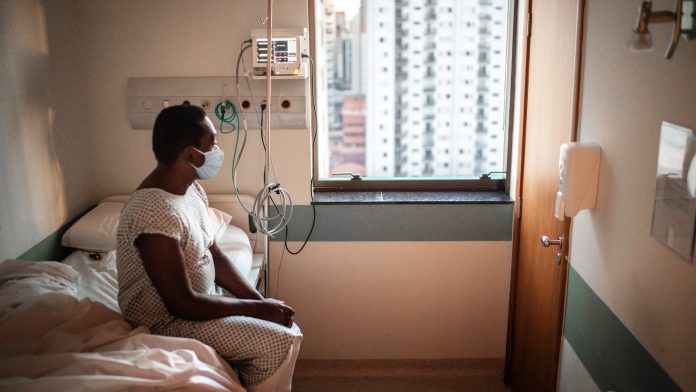
A new study has found that the monkeypox virus can be shed into the surrounding environment by infected people, specifically from infected skin particles caused by skin lesions.
Current recommendations from the UK Health Security Agency (UKHSA) advise patients with severe monkeypox requiring hospitalisation should be cared for in isolation rooms, with infection control measures in place. Yet, it remains unclear whether infection prevention methods are proportionate to the potential virus exposure risks.
To explore this, researchers from the Liverpool School of Tropical Medicine, the University of Oxford’s Nuffield Department of Medicine and the UKHSA studied samples from hospitalised patients. The findings are published in The Lancet Microbe.
How easily does monkeypox virus shedding spread?
The researchers assessed monkeypox virus shedding onto surfaces in specialist isolation rooms and whether the virus was detectable in air samples from the rooms.
They found viral DNA shed by the patients on multiple surfaces throughout the isolation rooms (56 positives by PCR out of 60 samples). Monkeypox virus DNA was found on the personal protective equipment (PPE) worn by the healthcare workers caring for the patients and in the anterooms where they removed their PPE. It was also detected in five out of 20 air samples taken in these isolation rooms.
Changing bed linen was an activity specifically associated with monkeypox virus DNA shed in air samples. This suggests that viral particles, likely shed skin particles, become suspended in the air when bed sheets are changed. The virus was capable of replicating in cells under laboratory conditions (an indicator that the virus could infect other people) was identified in two of four PCR-positive samples selected for virus isolation. This includes air samples collected during the bed linen change.
Lead author Dr Susan Gould from the Liverpool School of Tropical Medicine, said: “Our results found that changing a patient’s bedding appears to be particularly associated with an increased ability to detect monkeypox virus in air samples. In 2018, a UK healthcare worker was thought to have developed monkeypox after being exposed to the virus while changing a patient’s bedding before monkeypox had been considered and diagnosed. Our results suggest that changing bed linen used by hospitalised patients with monkeypox does indeed increase the risk of exposure to the virus by disturbing the virus on bed linen and allowing it to be suspended in the air.”
Isolating the virus in surface and air samples
The researchers also isolated the replication-competent virus in some surface and air samples. The results show that the monkeypox virus in some air samples around patients hospitalised with monkeypox is capable of replicating in cells and is not just a ‘dead’ virus. Dr Gould said, “these results suggest that monkeypox virus shed into a hospitalised patient’s environment poses an infection risk that needs to be managed.”
Senior author on the paper, Dr Jake Dunning, of the University of Oxford’s Nuffield Department of Medicine and the Royal Free London NHS Foundation Trust, said: “It is important to note that detection of virus, even when demonstrated to be infectious, does not necessarily mean that exposure to the virus in real life would result in infection of the exposed person. However, it does reveal a potential transmission risk and one that is reasonable to control in hospital settings. Our results confirm that the strict IPC measures we follow in specialist infectious diseases centres are necessary and appropriate.”
This investigation specifically evaluated exposure risks when caring for monkeypox patients. The results and recommendations may, therefore, not apply to other settings, such as outpatient clinics where patients attend for a short time, interactions differ, and the virus is unlikely to accumulate to such an extent. There is no suggestion that transmission of the monkeypox virus via aerosols is a common way for the infection to spread from one person to another.
Dr Gould added: “In the context of ward-based care, our results support infection prevention and control measures designed to protect against exposure to the infectious virus on surfaces and in the air, such as appropriate PPE, as well as applying measures designed to contain shed virus within hospitalised patients’ isolation rooms, including the use of negative pressure rooms and doffing areas.”










